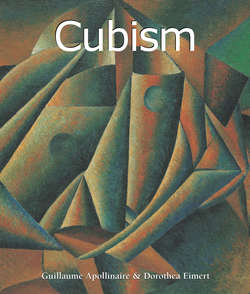Читать книгу Cubism - Guillaume Apollinaire - Страница 6
На сайте Литреса книга снята с продажи.
II. What Is Cubism?
The Merit of Material
ОглавлениеFrom ancient history until the end of the 18th century, artwork was evaluated according to its content. The material from which the artwork was made played a subordinate role. The premise was that an idea in its most complete and ideal state is immaterial; thus, to a great extent, the material is secondary to the idea that it is helping the artist to express. Materials were placed in the hierarchical order that was determined by how little they would impinge upon the purity of the artistic premise. Only in the 20th century did the aesthetics relating to materials take hold. Material justice now became one of the criteria for a good work of art, as materials rose in esteem.
Edgar Degas was a forerunner for the appreciation of so-called “poor” materials. At the 1881 Impressionist exhibition of the Salon des Indépendants in Paris, he displayed the Little Fourteen-Year-Old Dancer, which he had completed between 1879 and 1880. The flesh-coloured wax figure, with her ponytail made of real red hair, clothed in real clothes-a flax bodice, a full white dress and ballerina shoes-shocked the art world. The critics called the figure a “young monster”, and said that it evoked the idea of a specimen prepared for a zoological or physiological museum exhibit. However, the critic and poet Joris-Karl Huysmans vehemently defended Degas:
All the ideas the public has about sculpture, about cold, lifeless, white apparitions, about these memorable and stereotypical works that have been repeated over the centuries will be toppled. The fact is that Monsieur Degas has knocked over the traditions of sculpture, just as he has for a long time now shaken the conventions of painting. […] This statuette is the only really modern attempt that I am aware of in sculpture with her living flesh shaped throughout by working muscles.
A similar view was expressed in the letter Vincent van Gogh wrote at the end of February or beginning of March in 1883 to his friend Van Rappard: “Tomorrow, I will get some interesting things from this rubbish dump.” Like Degas, he would dream of the collection of discarded buckets, kettles, baskets, oil cans and wire, and would mould these materials into art in the following winter.
In 1890, Maurice Denis reflected on the materiality and substance of colour, space and technology: “A painting is essentially a tarpaulin surface covered by colours in a certain order.” To support this statement, he cited one of the many works of Félix Vallotton, Les Passants (Passers-By), dated 1897. The frame for the painting is a reddish brown cardboard box with fine fibre inserts. At certain strategic points in the canvas, the colour is lacking, baring the graphic structure. In doing so the artist revealed the beauty of the material.
In the later works of Paul Cézanne, large parts of the canvas also remain untouched. The level of sensitivity regarding the material quality of the painting is thus reflected. In his Blue and Rose Periods, Pablo Picasso gave the colours their independence. The papiers collés were the next logical step.
Georges Braque, Man with a Pipe, 1912.
Glued paper on Ingres paper and charcoal, 62 × 48.6 cm.
Kunstmuseum, Basel.
The themes and techniques of popular art influenced the development of modernist art. The avant-garde pioneers systematically acquired new sources of inspiration and the categorical separation between art, folk art and anti-art was lifted. Theodore Adorno specifically warned against comparing the insights of the modernist movement to similarities with older art. Only through the deliberate artistic use of techniques and material would the work become more than mere handicraft. He added that only when Braque and Picasso first pasted pieces of paper in the papiers collés did this have the intellectual spark that surpassed the effect and dexterity of previous expressions.
Georges Braque, Fruit Basket, Bottle and Glass, 1912.
Glued paper and charcoal, 62 × 46 cm.
Private collection.
Pablo Picasso, Still-Life with Chair Caning, 1912.
Oil on polished canvas wrapped with rope, 29 × 37 cm.
Musée Picasso, Paris.
Marcel Duchamp, The Bride, 1912.
Oil on canvas, 89.5 × 55.6 cm.
Philadelphia Museum of Art, Philadelphia.
Marcel Duchamp, The Passage from the Virgin to the Bride, 1912.
Oil on canvas, 59.4 × 54 cm.
Museum of Modern Art, New York.
Albert Gleizes, Brooklyn Bridge, 1915.
Oil on canvas.
Private collection.
The themes and techniques of popular art influenced the development of modernist art. The avant-garde pioneers systematically acquired new sources of inspiration and the categorical separation between art, folk art and anti-art was lifted. Theodore Adorno specifically warned against comparing the insights of the modernist movement to similarities with older art. Only through the deliberate artistic use of techniques and material would the work become more than mere handicraft. He added that only when Braque and Picasso first pasted pieces of paper in the papiers collés did this have the intellectual spark that surpassed the effect and dexterity of previous expressions.
